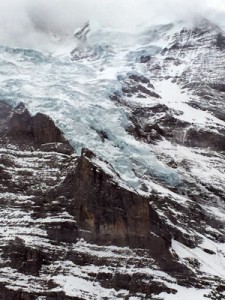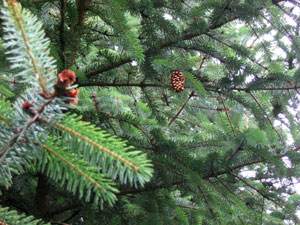Cold, wind, krummholz and clones.

Plants have different solutions to the onset of winter and exposure to cold. Some survive the cold as seeds - the rest of the plant dies; some over-winter as corms and bulbs. Deciduous trees and shrubs shed their leaves and become dormant, reducing their metabolism to a minimum - just ‘ticking over’. Some trees live at the very margin of their survival. As altitude increases or you move towards the poles so life becomes more difficult.
The tree line is the point at which trees can no longer tolerate the conditions. Near to this point, the growth of a tree is very limited; the tree is stunted or deformed, sometimes forming a bush-like structure. Such twisted and dwarfed vegetation is sometimes known as krummholz. It is to be found in sub-arctic and sub-alpine environments. These environments are characterised by cold and strong winds. Trees exhibiting this form of growth are invariably coniferous - often members of the larch, pine and spruce families.
Interestingly, the “oldest tree” known as Old Tjikko is to be found in a krummholz formation on the Fulufjallet mountain in the Dalarna province of Sweden. It is a Norway Spruce. The trunk of this “tree” is relatively young buts its DNA / genetic profile has been matched to other material at the site which suggests that it is a part of a clone, and that its root system has existed for some 9000 years.  For much of its existence, this clone existed as a krummholz due to the harsh condition, but during the twentieth century the clone sprouted into normal growth. Professor Leif Kullman (Umea University), who discovered the tree, has attributed the 'recent' growth spurt to global warming / climate change . There are other spruce trees / clones in the region that have been estimated to be 8000 years old. These plants must have established themselves not that long after the glaciers retreated from the last Ice Age - which came to an end some 10,000 years ago. Other work has suggested that Spruce has survived in these northern areas for many years.
For much of its existence, this clone existed as a krummholz due to the harsh condition, but during the twentieth century the clone sprouted into normal growth. Professor Leif Kullman (Umea University), who discovered the tree, has attributed the 'recent' growth spurt to global warming / climate change . There are other spruce trees / clones in the region that have been estimated to be 8000 years old. These plants must have established themselves not that long after the glaciers retreated from the last Ice Age - which came to an end some 10,000 years ago. Other work has suggested that Spruce has survived in these northern areas for many years.
The Norway Spruce is perhaps much more familiar at this time of year - as a Christmas Tree. It is in many ways the traditional British Christmas tree. It is an attractive tree but does have a tendency to drop its needles, particularly towards the end of the festive season. In recent years it has been overtaken by non-drop varieties such as the Blue Spruce and the Nordmann Fir.
Comments are closed for this post.
